The Most Magical Places on Campus? These Two Saint Leo Disney Classes
Read about two unique undergraduate honors classes on Disney focusing on literature and psychology offered at Saint Leo University this fall.

Read about two unique undergraduate honors classes on Disney focusing on literature and psychology offered at Saint Leo University this fall.

The Disney brand reaches far and wide around the globe. From its movies to theme parks to merchandise, Walter Elias Disney would likely be astonished at how much of a household name his surname has become over generations.
This fall, Saint Leo University offered two unique undergraduate honors classes on Disney. Let’s explore how they were developed, what they covered, and what students learned most from them.
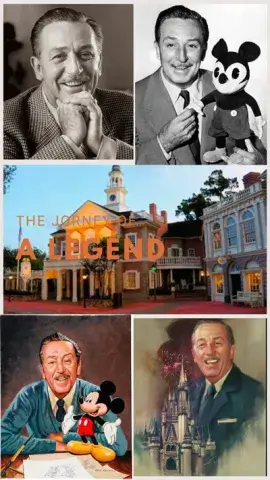
Dr. Kathryn Duncan, a professor of English, taught a class about how Disney stories are told through various forms of media. Duncan, a longtime Disney fan, has a few characters among her favorites.
“I like The Little Mermaid because I love to swim,” Duncan says. “I also like Princess Moana and the fact that she doesn’t have a prince. She is the one charged with rescuing people.”
The class had 20 students, all of whom are enrolled in a variety of degree programs. Duncan outlines the primary aim of the curriculum.
“We focused on transmedia storytelling,” Duncan explains. “We looked at methods of storytelling and how stories shift and change over time.”
The students examined three classic stories that have been adapted into Disney films – Winnie the Pooh, The Little Mermaid, and Peter Pan.
“We started by reading the original tales. Then we watched the Disney film versions of these stories. Then we went to the theme park to explore how these stories are translated into this more immersive medium.”
Reading the original book of The Little Mermaid from Hans Christian Andersen and contrasting it with the Disney film made a big impact on the students, Duncan says.
“The Andersen work is a very dark story,” she says. “The mermaid has to give up her voice and has her tongue cut out. It’s not a happy ending because she dies at the end. We talked about Andersen’s bleak life and how this might have influenced the story.”
The students then watched Disney’s film adaptation of The Little Mermaid.
“We talked about how it has so many modern tools at its disposal, including music, light, color, and verbal dialogue. Our experience of the story was so different because we were processing it differently. With Disney, all communication in their content is driven by purpose and audience.”
She elaborates on the major differences between reading text out of a book and consuming a visual film.
“When reading a story, all we have are words, and we have to use our imagination,” she explains. “A movie is a much more communal experience. Plus, others have made decisions on what the characters look and sound like. We’re responding viscerally, even though we’re not really aware of it. Oftentimes, the story is ‘Disney-fied’ to have a happy ending.”
Of course, the class would not have been complete without a trip to the Magic Kingdom theme park in Orlando. The class went on a Saturday in late October.
“The Disney theme parks are each an immersive story,” Duncan explains. “As a guest, you are one of the characters in the story. When we were there, we went on the Winnie the Pooh, The Little Mermaid, and Peter Pan rides. They explored what the story of each ride is, how the story is being told, and who they thought the intended audience is.”
They also took note of the merchandise on the shelves of the gift shops, another form of transmedia. For an adaptation project, the students identified a specific attraction at the park to creatively conceptualize it into a certain form of media.
“With this project, their job was to become a transmedia storyteller. They could take a ride and turn it into anything from a game, a film pitch, or a creative writing piece. They then had to explain how they would make these types of media. For example, they could create a short story out of Space Mountain.”
Duncan summarizes the biggest takeaways she believes the students had from the course.
“I think the students recognized that even if some type of media seems designed purely for entertainment purposes or is silly or childlike, there are important lessons that can be taken from studying them.”
Archanae “Nae” Cambridge, 20, is a sophomore working toward her BS in biology focusing on biomedical sciences. Originally from The Bahamas, she explains what piqued her interest in this class on Disney.
“Usually when you think about school, it’s obviously more focused on academics,” Cambridge says. “So, I wanted to see how something like the fun and entertainment of Disney would translate into a class like this. I mainly expected to talk about Disney characters and franchises, but it was so much more than that.”
In her childhood, her favorite Disney character was Mrs. Potts from Beauty and the Beast. She now feels a special connection to Wendy from Peter Pan.
“Seeing the type of character she was in the original work and then the Disney version of Peter Pan was fascinating,” she says. “Even though she is young, she is a motherly figure with a sense of responsibility. I can relate to her a lot because some of my friends call me ‘mom.’”
Cambridge originally visited Magic Kingdom around age 12. While going with the class this fall was nostalgic in some ways, it also made her look at the park from a whole new vantage point.
“All of the rides brought to life the stories we studied,” she says. “The rides allowed us to be more interactive with these stories in a way we couldn’t have been when reading or watching them. The immersion was really cool.”
This was her first class with Duncan. She would love to have her again.
“She is a perfect fit to teach this class because she admits that she’s a Disney nerd,” Cambridge says of the English professor. “What I like is that she allows us to interact with her a lot during class. It didn’t feel like a class where you’re being ‘taught at’ by a lecturer. Instead, we were all learning together as a collective group.”
For her adaptation project, she focused on designing a ride incorporating the factory in Monsters Inc. And what is the most significant concept she has learned from the class?
“The people behind Disney are extremely purposeful in everything they do,” she says. “Everything is perfectly done because Disney pays great attention to detail. Examining how these stories are told makes me feel more comfortable to be a Disney consumer and excited to learn about other stories. I think they really value their customers from all backgrounds, and they try to be super inclusive.”
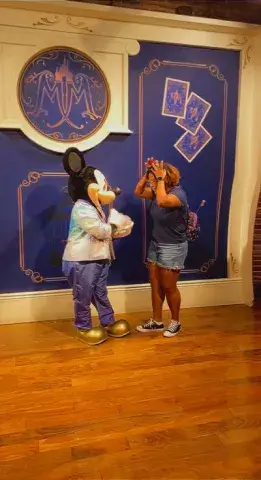
Doriann Pina, 21, was another student in the course. A native of Cape Verde in Africa, she is a senior also majoring in biology on the biomedical sciences track. She details her early exposure to the Disney brand.
“I first came in contact with Disney by watching the Disney Channel,” Pina recalls. “I was obsessed with Disney shows and stars. I couldn’t wait to visit the U.S. someday to go to Disney World. I also wanted to learn what is behind every movie and show. I realized this class would be perfect for me.”
She is fluent in Cape Verd Creole, Portuguese, and English. Thanks to watching Disney movies and listening to their soundtracks, she has improved her English skills.
“Growing up, I would watch movies and shows with dialogue in English and captions in Portuguese.”
Her favorite character is Princess Moana because of how much of an independent woman she is. She even got to interact with her at Magic Kingdom.
“I got to meet Moana and cried a little bit,” she says. “I also met mickey, and he complimented me on my Mickey ears. It was an absolutely magical experience. It really was very immersive. The fireworks were one of my favorite things.”
Pina based her adaptation project on the Hall of Presidents attraction, but with a bit of a twist.
“This attraction was something Walt Disney himself wanted to develop,” she says. “My idea was to create a show every year on his birthday, December 5. It would be a show highlighting the journey of his life where Mr. Disney appears as a hologram, and then the characters follow him into his afterlife.”
She adds that the class on Disney was a breath of fresh air for her in many ways.
“Since my major is in a science field, taking this type of class brings out the creative side of me,” she says. “Plus, Dr. Duncan is like a child in an adult body, but in a good way. She’s definitely a Disney addict, making the class even more interesting because she knows so much about Disney. The fact I got three hours with her every week to kind of go back to my childhood was amazing.”
Dr. Tammy Lowery Zacchilli, a professor of psychology, taught this Disney-oriented psychology class. The course had 21 students from a variety of majors. Zacchilli says she had wanted to teach such a class for many years.
“I’m a Disney fanatic,” Zacchilli says. “I love Disney and psychology. It was like a dream come true for me to get to teach this class.”
Her favorite character is Sleeping Beauty. She also likes the Maleficent movies, Alice in Wonderland, and the Robin Hood animated film. When designing the course curriculum, she selected a handful of major themes in the psychology field that the students then applied to Disney films.
“I realized many of these honors students had never taken a psychology class, so figuring out how to best present the material was a bit challenging,” she says. “I wove consumer psychology throughout the class to look at how not only psychology applies to movies, but also to the Disney corporation in general.”
The students explored family and romantic relationships, gender roles, stereotypes, mental health, and other psychological themes. They had to write application papers answering a series of questions about each movie they viewed. Zacchilli also paired up students for some thought-provoking debates, such as whether children should be allowed to watch certain Disney movies and the affordability of visiting the Disney theme parks. Additionally, they did group presentations using short clips from Disney movies.
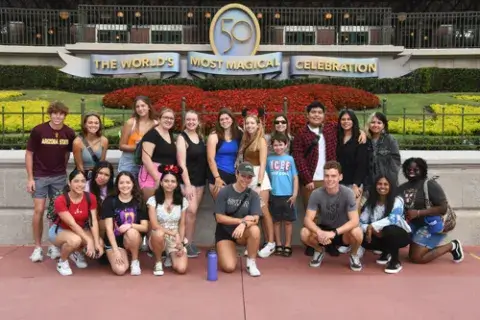
On the same day the students from Duncan’s Disney literature course visited Magic Kingdom, Zacchilli’s class was also there. Their role was to be keen onlookers of their environment.
“I wanted them to make some observations about psychology going on at the park,” she says. “They could focus on three areas. These included the consumer route to observe the buying patterns of the guests in the gift shops. Another option was to look at the parent and child interactions and behaviors. Were the kids really happy being there? Did the parents look frustrated? Finally, they Could look at the behavior of couples. Were they holding hands or wearing matching Disney shirts?”
And what did she enjoy most about getting to teach a class on Disney?
“It was really nice to see them learn and grow in terms of psychology,” she says. “As I’ve watched Disney movies, I’ve thought of these things. To see students apply these psychological theories to popular movies is rewarding.”
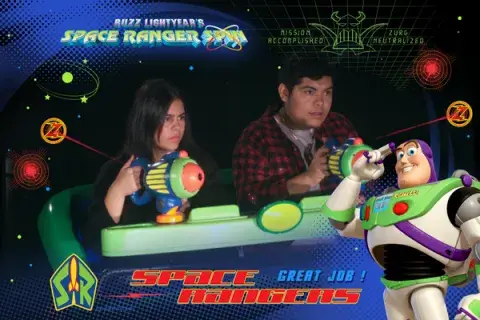
Brooke Varn, a 21-year-old alumna of Plant City High School, is a senior political science major with a communication minor who took the class.
“The trip to Disney definitely sold me on taking it,” Varn says. “I had never taken a psychology class before, but it was really interesting learning how the human brain works.”
She likes Stitch of Lilo & Stitch fame and Mater from the Cars franchise. One point of discussion that stood out to her in the course was considering the mental health aspects of the Winnie the Pooh film.
“I watched this movie growing up, but I never realized how dark it actually is. We examined the stages of grief and mental health disorders. It makes you sit back and watch it in a whole new light as an adult.”
Varn enjoyed debating with a fellow student, Haylie Williams, and says the two worked well together in the class. As for the field trip, she like the concept of experiencing a theme park using a different lens.
“It was cool because I got to partner with another student to watch kids’ reactions to meeting characters,” she says. “We also watched kids ride a rollercoaster for the very first time and observed the psychology involved in how some of the rides are designed.”
She is extremely grateful to how Zacchilli guided the students in the course.
“She is one of the most amazing professors I’ve ever had at Saint Leo,” Varn says. “She is a big Disney fan and was always very excited to come to class. She is willing to help us with anything and provides helpful and timely feedback on our assignments.”
Another student in the class was 20-year-old Pia Perthen. A native of Austria, the sophomore majoring in cybersecurity with a psychology minor competes on the women’s golf team and serves as sports editor of the Lions’ Pride Media Group.
In her childhood, she was a big fan of the Winnie the Pooh character. She is still very into Minnie Mouse. She recently watched Coco and enjoyed that movie.
At Magic Kingdom, Perthen focused on the theme of couples who were there.
“I looked at how couples were dressed,” Perthen says. “Some were wearing ‘I’m his Minnie’ and ‘I’m her Mickey’ shirts. I also noticed that couples without kids were more engaged with each other. Couples with kids tended to focus more on them compared to their partners.”
She sums up why the class made her think more critically.
“This class was very eye opening,” she says. “There is so much psychology involved in these movies that a lot of people don’t realize. I now ask myself if I would want my children watching some of them. I’ve never really thought about things like that before.”
Hannah Evers was also in the course. A 20-year-old transfer student from Texas, she was drawn to Saint Leo University for the opportunity to play on the women’s soccer team. Her close friend, Malloree Enoch, is also a 2011 alumna. Evers is majoring in biology focusing on biomedical sciences. She also serves as an honors captain of the House of Assisi within the Honors Program.
“It was really interesting looking at movies through a different perspective and trying to identify psychological principles in them,” Evers says.
Olaf from the Frozen franchise is her favorite Disney character. While Evers was unable to attend the field trip, she recalls previous observations she has made at theme parks.
“It is interesting how kids interact with their parents and how their parents discipline them in these environments. When you’re in a ‘magical’ place, a lot of people kind of forget about rules and let things slide. One of our class discussions was about how to teach kids from right and wrong.”
Evers appreciated how easygoing Zacchilli was as a professor.
“She wears flipflops to class a lot of the time,” she says. “Having briefly lived in Hawaii, I noticed this about her. People like this tend to be more laidback and relatable, and this is not always the case with college professors. She also tried to make the class fun. She brought in Disney pins so we could do pin trading with each other.”
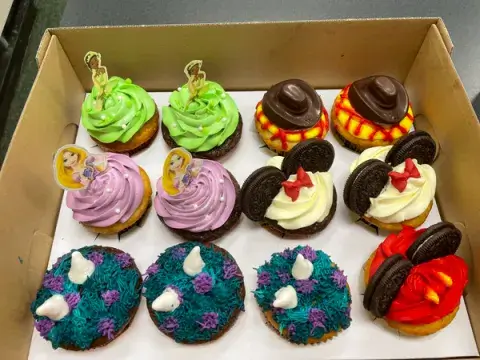
And what are her biggest takeaways from studying the psychology of Disney?
“We learned to dive deeper into what we do in our lives and the importance of seeing things from others’ perspectives,” Evers says. “Everything has an underlying meaning. Don’t look at everything so superficially. Try to understand the message being presented to you.”
Photo credit: The photographs included in this blog article were provided by the faculty members and some of the students in the Disney courses and are used with permission.